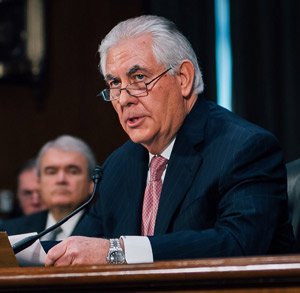Secretary of State Rex Tillerson just called for the United States and India to expand their strategic ties in the South China Sea.

Yesterday, the former Exxon Mobil CEO brought up what he referred to as his vision of an "Indo-Pacific order," stretching from the U.S. West Coast to India, reported CNN today.
This order would be underpinned by the United States and its Pacific allies, which include India as well as countries in the Association of Southeast Asian Nations (ASEAN) like the Philippines, Malaysia, and Vietnam.
Tillerson described the U.S.-India relationship, in particular, as one between two "increasingly global partners" who share both an "affinity for democracy" and a "vision of the future," reported BBC News on Wednesday.
Indeed, the United States and India share goals of security, free navigation, free trade, and fighting terrorism in the Indo-Pacific waters.
They also share one particular objective that - if tackled together - could bring the single-most powerful Asian nation to its knees:
Subverting China's sweeping sovereignty claims in the South China Sea.
Here's why the United States needs India's help - and what the results of this alliance mean for investors...
Everything Hinges on the Strait of Malacca
India has recently claimed a vital South China Sea trade route for itself, and the United States wants to press the advantage.
The Strait of Malacca - a waterway between Malaysia and Indonesia that, at its narrowest point, is only 1.5 nautical miles wide - plays host to over half of the world's commercial shipping. Furthermore, 25% of the world's sea-traded oil runs through this strait, which makes it one of the world's most noteworthy strategic choke points, as well.
Don't Miss: North Korea is "fake news" - this is where WWIII will start. Read more...
 And just this year, India challenged China's claim to the Strait of Malacca. India sent warships to secure this region in April. And in May, India conducted joint military exercises with Singapore in the strait, "reneging" on previous promises not to provoke China on the sensitive issue of regional sovereignty.
And just this year, India challenged China's claim to the Strait of Malacca. India sent warships to secure this region in April. And in May, India conducted joint military exercises with Singapore in the strait, "reneging" on previous promises not to provoke China on the sensitive issue of regional sovereignty.
"India had promised not to take sides and provoke China on the South China Sea disputes. But the country is reneging on its promise by conducting such major drills in the area," Song Zhongping, a Chinese military expert, said, according to the state-run Global Times on May 22.
And now, mere months after India claimed control of the Strait of Malacca, Tillerson is pushing an "Indo-Pacific order."
The Secretary of State's declaration suggests that the United States intends to establish a presence in the Strait of Malacca so it can push for free trade across the entire South China Sea and beyond.
It will likely do so by sending U.S. warships to the strait to conduct freedom of navigation maneuvers (FONOPs). These maneuvers are already happening - and have been for some time - around ASEAN nations in the South China Sea.
This could work, but it could also get ugly - fast.
Fortunately, there are profit opportunities no matter which way the wind blows...
[mmpazkzone name="in-story" network="9794" site="307044" id="137008" type="4"]
How You Can Profit from the South China Sea
In order to successfully tame China's sweeping claims to the South China Sea, the United States will need to throw its weight around. And in the 21st century, that weight comes in the form of the most advanced defense tech in the world.
The iShares U.S. Aerospace & Defense ETF (BATS: ITA) owns many, if not most, of the firms involved in today's defense industry mergers.
And the growth in this ETF is accelerating. It only grew 1.75% in 2015, but 19% in 2016, and it's up a whopping 30% year to date (YTD). And now that the United States is trying to increase its presence in the South China Sea, you can bet this growth is just getting started.
Of course, increased FONOPs could have the opposite effect if China doubles down on its South China Sea presence, instigating a trade war with the United States.
Don't Miss: Tensions in the South China Sea could boil over at any time. Investors who stay on top of the news will reap massive gains. Get real-time alerts sent to your inbox, completely free, here.
Although very few industries benefit from reduced trade, you can protect your money by focusing on the internal growth in the world's most populous nation. Check out the Emerging Markets Internet & E-Commerce ETF (NYSE Arca: EMQQ).
You see, China is home to a number of fast-growing web companies, like Alibaba Group Holding Ltd. (NYSE: BABA), Tencent Holdings Ltd. (OTCMKTS: TCEHY), and JD.com Inc. (Nasdaq ADR: JD), whose success is more dependent on China's rapidly modernizing population of 1.3 billion than it is on trade.
This fund has surged 63% YTD - four times the Dow's 2017 rally.
If the South China Sea gets ugly, you'll want this safety net.
Up Next
Hostilities in the South China Sea now seem imminent, and the Trump administration could be on the verge of its first major crisis.
But thanks to a small $6 U.S. defense firm with a top-secret new technology, China is about to be taken to the woodshed.
Frankly, you have to see it to believe it...
Follow Money Morning on Facebook, Twitter, and LinkedIn.
Related Articles:


